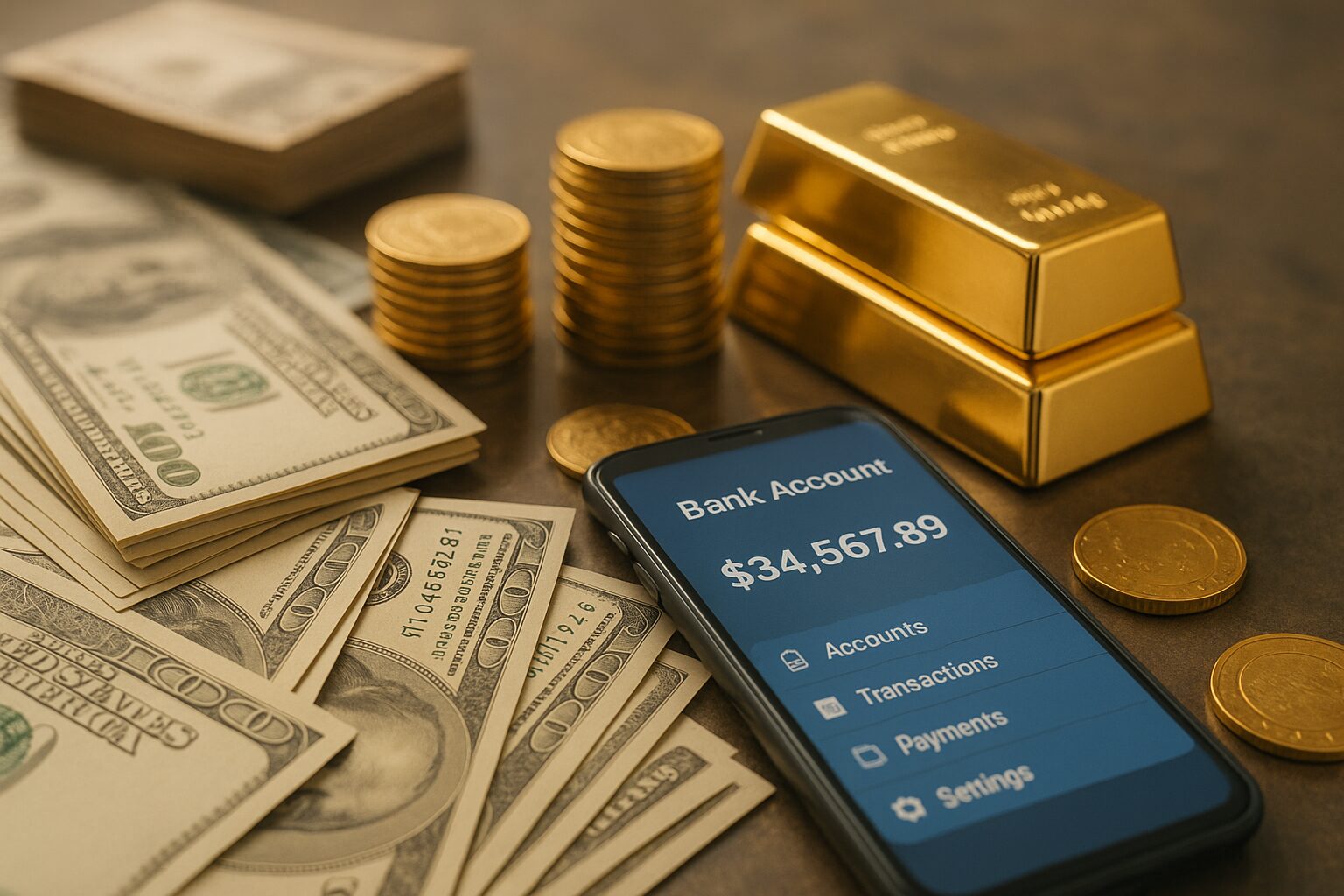Have you ever wondered how much money is in the world today? From the cash in your wallet to the digital numbers on your banking app, money exists in many forms — and its total amount can be mind-blowing.
As we move further into 2025, the world’s wealth continues to grow, evolve, and shift between cash, digital deposits, cryptocurrencies, and real assets like gold and real estate. Understanding the global money supply helps us make sense of economic trends, inflation, and the growing gap between rich and poor.
In this article, we’ll explore how much money truly exists, how it’s distributed, and what the future of global wealth might look like in an increasingly digital age.
Defining “Money”: What Counts as Money in the World?
Before we count the world’s money, we first need to define what “money” really means.
Money isn’t just paper bills or coins. It includes digital balances, investments, and assets that can be easily converted into cash. Economists categorize money into different levels called M0, M1, M2, and M3 — each representing broader forms of liquidity.
- M0 – Physical currency in circulation (cash and coins).
- M1 – M0 + demand deposits (money in checking accounts).
- M2 – M1 + savings accounts and short-term deposits.
- M3 – M2 + large deposits and institutional funds.
In simple terms, M0 is the cash we can touch, while M3 includes nearly every financial asset that can be quickly turned into money.
The Total Amount of Money in the World (2025 Estimates)
So, how much money is in the world today?
According to recent global financial reports, the total value of all money in the world in 2025 is estimated to be over $1.3 quadrillion USD — but this number depends on what we count.
Here’s a breakdown:
| Category | Description | Estimated Value (2025) |
|---|---|---|
| M0 (Physical Cash) | Notes and coins in circulation | ~$8–10 trillion |
| M1 (Cash + Checking) | Cash + easy-to-access deposits | ~$65 trillion |
| M2 (Savings + Time Deposits) | Includes M1 + savings | ~$120 trillion |
| M3 (Broad Money) | Includes large deposits and money markets | ~$150 trillion |
| Total Global Money Supply | Approximate combined figure | ~$345 trillion |
| Global Wealth (All Assets) | Includes stocks, real estate, crypto, etc. | ~$1.3 quadrillion |
(Sources: IMF, World Bank, Global Wealth Report 2024)
📊 Visual Suggestion:
Insert a pie chart or bar graph comparing M0–M3 categories for visual understanding of the money supply.
This helps us see that most money isn’t physical. In fact, over 90% of the world’s money exists in digital form — as numbers stored in bank systems.
Global Wealth Distribution
Money isn’t equally shared. According to the Credit Suisse Global Wealth Report, global wealth surpassed $500 trillion in 2024 — but the distribution is deeply uneven.
- North America holds around 36% of global wealth.
- Europe owns roughly 25%.
- Asia-Pacific contributes around 20%, led by China and Japan.
- Africa and Latin America together hold less than 5%.
And here’s a staggering fact:
The top 1% of the world’s population owns nearly half of all global wealth, while the bottom 50% share less than 10%.
Visual Suggestion:
Insert a world map heat chart showing which regions hold the most wealth.
This imbalance continues to grow as assets like stocks and real estate appreciate faster than average incomes — widening the global wealth gap.
How Much of the World’s Money Is in Cash vs. Digital Form?
The shift from physical to digital money has accelerated since the pandemic.
- Only about 8–10% of the world’s money exists as cash or coins.
- Over 90% exists digitally in bank systems, online transactions, and central bank reserves.
Digital banking, credit cards, and online wallets like PayPal and Apple Pay have changed how we store and spend money.
Countries like Sweden and South Korea are close to becoming cashless societies, while emerging economies are expanding mobile payment systems.
Central banks also play a huge role — they control how much money enters or leaves circulation.
The introduction of Central Bank Digital Currencies (CBDCs) marks another step toward a fully digital economy.
Did You Know?
China’s digital yuan (e-CNY) and the European digital euro are already being tested for mainstream use.
The Role of Gold, Stocks, and Other Assets
When we talk about “wealth,” it’s not just money — it’s also the assets that hold value.
Here’s a breakdown of global asset values (2025 estimates):
| Asset Type | Estimated Value |
|---|---|
| Real Estate | ~$380 trillion |
| Equities (Stocks) | ~$110 trillion |
| Bonds | ~$140 trillion |
| Gold | ~$12 trillion |
| Cryptocurrencies | ~$2.5 trillion |
These assets together make up the total global wealth — roughly $1.3 quadrillion when combined with financial instruments.
Gold, despite being an ancient store of value, still plays a major role in global reserves. Central banks collectively hold over 35,000 tons of gold, valued at nearly $2.3 trillion.
Related Article: Why Gold Remains a Safe Haven Investment
Cryptocurrency’s Place in Global Wealth
Cryptocurrency, once a niche innovation, is now a major part of global wealth discussions.
As of 2025:
- The total crypto market capitalization sits around $2.5–3 trillion, led by Bitcoin and Ethereum.
- Bitcoin (BTC) alone holds over $1 trillion in value.
- Ethereum (ETH) and stablecoins like USDT and USDC dominate transaction volume.
Although crypto still makes up a small fraction of total wealth, its growth is remarkable — from under $20 billion a decade ago to trillions today.
Central banks are also exploring CBDCs, bridging the gap between fiat money and blockchain innovation. These could redefine how global money is issued and transferred in the near future.
Visual Suggestion:
Line graph showing crypto market cap growth (2013–2025)
How Inflation and Economic Growth Affect the Global Money Supply
Money isn’t static — it changes in response to economic growth, government spending, and inflation.
For example, after the 2020 pandemic, many countries printed more money to support their economies.
In the U.S. alone, the money supply (M2) rose by over 40% between 2020 and 2023. This influx contributed to global inflation and rising living costs.
Economists often track GDP (Gross Domestic Product) alongside money supply to gauge balance. If money grows faster than real productivity, inflation tends to follow.
By 2025, global GDP is projected at around $108 trillion, with steady but uneven recovery across regions.
Future of Global Money: Digital Transformation and Wealth Shift
The future of money is digital, data-driven, and decentralized.
Key trends shaping the future include:
- Tokenized assets: Real estate, art, and commodities being traded on blockchain.
- AI in finance: Automated trading, risk analysis, and fraud detection.
- Global digital currencies: Faster, borderless transactions.
But one big question remains — will physical money disappear?
While cash may not vanish completely, its importance will continue to decline as digital systems and crypto become more integrated into daily life.
Conclusion
So, how much money is in the world today?
In 2025, there’s roughly $345 trillion in traditional money supply, and over $1.3 quadrillion in total global wealth when assets are included.
Most of it exists digitally — not as physical bills, but as numbers on screens.
Understanding where money resides and how it circulates helps us make smarter financial decisions, protect our savings from inflation, and see the bigger picture of the global economy.
The world’s wealth keeps expanding — but so does inequality. As we move toward a digital future, it’s up to global leaders and individuals alike to shape a more balanced financial landscape.
FAQs
1. How much money exists in the world right now (2025)?
About $345 trillion in the money supply and over $1.3 quadrillion in total global wealth, including assets.
2. How much is in cash vs. digital form?
Only around 8–10% is physical cash; the rest exists digitally through banks and financial systems.
3. Who controls most of the world’s money?
The top 1% of wealthy individuals and corporations hold nearly half of the global wealth, according to Credit Suisse.
4. How does cryptocurrency affect global wealth totals?
Crypto adds roughly $2.5–3 trillion to total wealth and continues to grow as adoption expands.
5. Is the amount of money in the world increasing?
Yes. The global money supply increases yearly due to economic growth, inflation, and digital expansion.
Disclaimer
This article is for educational and informational purposes only. Figures and estimates are based on public data from credible sources such as the IMF, World Bank, and Global Wealth Reports. They may vary depending on market fluctuations and economic changes. Always do your own research or consult a financial expert before making investment decisions.



